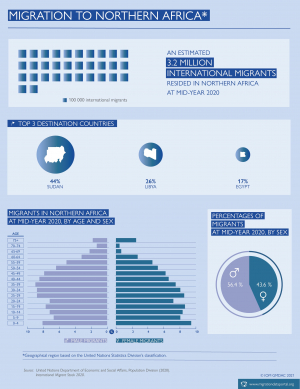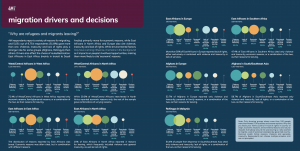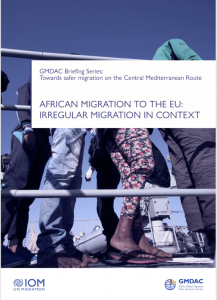
Migration data in Northern Africa
The six countries in Northern Africa1
– Algeria, Egypt, Libya, Morocco, Sudan and Tunisia – have historically been and remain significant countries of migrant destination, transit and departure. Economic, environmental and political instability contribute to the mixed migration patterns observed in the sub-region. Labour migration policies from as early as the 1950s incentivized mobility and played a role in the socioeconomic development of several Northern African countries (World Bank, 2010). Recent migration policies in the sub-region have affected human mobility trends, as well as migration route decisions.
At mid-year 2020, the sub-region hosted an estimated 3.2 million international migrants, nearly 61 per cent of whom were either from the same sub-region or other African sub-regions (UN DESA, 2020). An estimated 49 per cent of all international migrants in the region were refugees and asylum seekers. Globally, an estimated 12.3 million international migrants -- 4.4 per cent of the global migrant population -- were from Northern Africa. Of these emigrants, 48 per cent and 13 per cent were hosted in Europe and Western Asia respectively (ibid.).
- 1As defined by the UN Statistics Division
Recent trends
-
COVID-19: The pandemic has largely impeded mobility in Northern Africa whereby more than 80 per cent of the international airports were fully closed during April and May 2020 except for emergency and humanitarian flights. Additionally, between 80 and 90 per cent of land border crossing points and seaports were closed. In response, many Northern African countries were lenient towards expiry of permits and visas or overstay fines, as well as temporarily opening borders for stranded migrants to return home (IOM, 2020a).
Between July and September 2020, many countries lifted their restrictions. Sub-Saharan flows into Northern African countries were particularly impacted by COVID-19 mobility restrictions. Sudan experienced a 32 per cent decline in South Sudanese flows via the Abyei border point compared to 2019, while Algeria experienced a reduction in flows from Mali by 21 per cent and from Niger by 30 per cent. Niger’s outgoing flows to Libya also declined by 44 per cent (IOM, 2020b). Although borders progressively re-opened, migrants still disproportionately suffered from major socioeconomic consequences as a result of the mobility restrictions. For example, in Libya, where COVID-19 cases exponentially increased, 90 per cent of daily labor migrants were negatively affected (such as experiencing loss of livelihoods) while 27 per cent of the assessed migrants were found to be potentially food insecure (IOM, 2020c).
For an overview of migration data relevant to COVID-19 including data covering Northern Africa, visit the Portal’s new thematic page.
-
HOST COUNTRIES: Sudan (1.4 million), Libya (826,537) and Egypt (543,937) were estimated to be the three countries hosting the highest number of international migrants in the sub-region at mid-year 2020 (UN DESA, 2020).
-
DESTINATION COUNTRIES: The highest number of emigrants from Algeria, Morocco and Tunisia live in Western European countries, while the highest number of emigrants from Egypt, Libya and Sudan live in Western Asian countries (ibid.).
- REMITTANCES: Countries in Northern Africa received an estimated 37.6 billion USD in remittances in 2019 (World Bank, 2020).
- REFUGEES: At the end of 2019, an estimated 1.4 million refugees were hosted in the sub-region and approximately 789,766 refugees around the world were from the sub-region (UNHCR, 2020).
- DISPLACEMENT:
- 272,000 and 84,000 Sudanese were newly displaced in 2019 due to disasters and conflict respectively (IDMC, 2020). More than 2.4 million Sudanese lived in displacement as of December 2019 (ibid.).
- Ongoing armed conflict in Libya continued throughout 2019 and 215,000 people were newly displaced in 2019 (ibid.). As of October 2020, a total of 316,415 people were displaced, 88 per cent of whom were displaced due to the deteriorating security situation (IOM, 2020d).
- ARRIVALS IN EUROPE:
- Among all irregular arrivals in Europe, there was a 75 per cent decrease in the total number of migrants who reported Northern African countries as their nationalities during the period from January to September 2019, compared to the period from January to December 2018 (IOM, 2019a).
- Since the memorandum of understanding between Libya and Italy was signed in 2017 to improve migration management in Libya, the number of arrivals through the Central Mediterranean Route has gone down from 119,369 in 2017 to 23,370 in 2018 and 2,779 in the first half of 2019 (IOM, 2019b).
- MIGRANT DEATHS: Between 2015 and 2020, identified people from Northern Africa made up the smallest proportion of all Africans who died annually during migration (IOM, 2021).
Past and present migration patterns
1) Migration to Europe from the Maghreb2
countries
The influence of bilateral labour policies on the migration trends of Maghreb countries has been widely researched. In the early twentieth century, the sub-region’s geographic proximity to Europe, along with socioeconomic disparities between origin and destination countries following independence and the First and Second World Wars, enabled Europe’s guest worker programmes to attract migrants from Algeria, Morocco and Tunisia (Natter, 2014).
1950 – 1973
- High levels of youth unemployment following the independence of Maghreb countries and post-war reconstruction’s demand for labour in Europe fostered guest worker programmes and emigration mainly to France, as well as Belgium, the Netherlands and Germany (Natter, 2014). According to World Bank data on global bilateral migration, which is based on the foreign-born population, France was the destination country for an estimated 2 million migrants from Algeria, Tunisia and Morocco in 1970 alone.
1973 – 1990
- The economic recession in Europe caused by the 1973 Oil Crisis shifted migration patterns significantly and was a turning point for recruitment under the guest worker programmes (de Haas, 2007). The bilateral quota system through which migrants emigrated to Europe from Algeria, Morocco and Tunisia was stopped in Algeria in the same year.
- However, emigration from Northern African countries to Europe continued, largely using family reunification channels (Natter, 2014). Restrictive immigration policies following the 1973 Oil Crisis limited opportunities for re-entry to Europe and in turn lowered the rate of return of those already in Europe back to Maghreb countries. This disruption of the circular migratory pattern due to the end of the guest worker programmes negatively impacted Maghreb economies, particularly Morocco, resulting in an increase in net emigration from these countries (de Haas, 2005).
1990 – 2000
- While emigration from Algeria to Europe continued to decrease into the mid-1990s, labour gaps in Southern European countries encouraged migration from Morocco and Tunisia (de Haas, 2005). The introduction of visa requirements in Italy and Spain in 1990 and 1991 respectively decreased this trend.
2000 – 2020
- As of mid-2020, an estimated 1.7 million Algerians, 1.6 million Moroccans and 529,759 Tunisians lived in Western European countries (UN DESA, 2020).
2) Migration to the Gulf from Egypt, Libya and Sudan
1973 – 1990
- Remittances have supported the development of Egypt’s economy since the early 1970s. The 1973 Oil Crisis and subsequent demand for labour in the Middle East had a significant influence on migration from Egypt to the Gulf Cooperation Council (GCC) countries3
and Libya. Attention shifted away from Arab emigration to the GCC countries in the 1980s when the GCC turned towards bilateral labour agreements with Asian countries (De Bel-Air, 2016).
1990 - 2020
- The UN Security Council embargo on Libya between 1992 and 2000 resulted in policy changes that increased land entries from neighbouring countries, facilitating labour market access to migrants from Egypt (de Haas, 2007). Although the GCC entered into several bilateral agreements with Asian countries, the general high demand for labour in the region in the 1990s meant this had minimal influence on Egyptian emigration numbers which remain high today. The top three destination countries for Egyptian emigrants as of mid-2020 were Saudi Arabia, the United Arab Emirates, and Kuwait (UN DESA, 2020).
- The underlying causes of emigration from Sudan include both economic and political instability (IOM, 2011). Conflict with the South following independence in 1956 escalated into two civil wars, the second ending in 2004. Overlapping this, in the 1990s and 2003, conflicts in the East and Darfur resulted in 200,000 to 400,000 deaths (ibid.). The Secretariat of Sudanese Working Abroad (SSWA), jointly with IOM, estimated the number of Sudanese economic migrants to be between 880,000 and 1,338,00 in 2011, with the majority residing in Saudi Arabia. Since then, emigration has slowly decreased with more returns being counted.
Internal displacement and intra-regional mixed migration flows
Libya - Labour migration to Libya from neighbouring countries has been observed since Libya’s independence, with peaks in the 1970s and 2000s respectively. Studies conducted by the Reach Initiative indicate that migrants moved to urban areas in Libya in search of work, often in order to acquire the resources necessary to either settle in the country or to support onward migration. Immigration flows to Libya continued by means of ‘open-door’ migration policies for sub-Saharan African countries implemented following the 1992 UN embargo, ending in 2007 with the implementation of visa requirements for Africans and Arabs. Four years later, the outbreak of conflict resulted in the fleeing of 768,372 migrants in 2011 alone (Migration Policy Centre, 2013).
The second civil war in Libya erupted in 2014, and internal displacement due to armed conflict and insecurity around Tripoli and in the south continued into 2020. By the end of October 2020, 316,415 internally displaced persons (IDPs) and 567,802 returnees were identified in Libya. 88 per cent of the IDPs interviewed in October 2020 reported that they had left their places of origin due to security-related issues and 91 per cent of the interviewed returnees reported that they returned due to an improved security situation (IOM, 2020d).
On the Central Mediterranean Route (CMR), East African migrants and refugees usually transit through Libya by crossing the Sudanese border south-east of Kufra, while those from West and Central Africa cross from Niger to the south of Sebha. Other entry points through Tunisia, Algeria and Egypt are also used (Darme and Benatita, 2016). However, the number of irregular arrivals via this route has seen a significant downward trend since 2016 (UNHCR, 2019).
Morocco - On the Western Mediterranean Route (WMR) to Spain via sea and land, Morocco remains the main transit point in the sub-region. Between 2017 and 2018, there was a major shift in the number of irregular arrivals from the CMR to the WMR (UNHCR, 2019b). The total number of irregular arrivals in Spain increased from 8,613 in 2016 to 22,414 in 2017 and 58,525 in 2018 and decreased to 25,731 in 2019 (IOM, 2020b).
Sudan - Due to its geographic location along the East African route, Sudan is an origin, transit and destination country for migrants from and to several neighbouring countries. At the end of 2019, an estimated 1.1 million refugees and asylum seekers were hosted by the country (UNHCR, 2020). The protracted nature of conflict in Sudan, following two civil wars with the South and genocide in Darfur, have heightened internal displacement in the country over time. Environmental factors such as drought and famine have also exacerbated the displacement situation. 121,000 and 41,000 people were reported to have been newly displaced in 2018 due to environmental drivers and conflict respectively (IDMC, 2019). By the end of 2019, another 272,000 and 84,000 people were newly displaced in Sudan due to disasters and conflict respectively (IDMC, 2020). As of December 2019, more than 2.4 million individuals were identified as living in displacement in Sudan (ibid.).
Data sources
United Nations Department of Economic and Social Affairs (UN DESA)’s Population Division – regularly publishes data on the international migrant stock, the latest being for mid-year 2020. The published estimates draw on official national statistics on the country of birth, and where data on the foreign-born were not collected, based on the country of citizenship. Available data are estimates of:
- Migrant stocks by sex and country; total population by area, region and country; migrant stocks as a percentage of total population; annual rate of change of migrant stocks by area, region and country
- Refugee and asylum-seeker stocks by area, region and country
- Total migrant stock by destination and origin; total migrant stock by sex, destination and origin.
UNHCR’s Population and Statistics portal – provides statistics on refugees and asylum seekers for the region. Its interactive dashboard allows users to filter by year, country of asylum, country of origin and type of persons of concern (including refugees, asylum-seekers, returned refugees, IDPs, returned IDPs and stateless persons). Demographic breakdowns (age and sex) by year and country of asylum can also be viewed.
UNHCR’s Operational Portal on Refugee Situations – provides data on the situation in the Mediterranean and statistics on total arrivals by land and sea, estimates on dead and missing persons, most common nationalities of arrivals via the Mediterranean Sea and land, as well as monthly aggregations and demographic information.
IOM’s Displacement Tracking Matrix (DTM) – a data collection tool designed to track and monitor displacement and mobility by collecting information on the volume and basic characteristics of populations transiting through established Flow Monitoring Points. More information on displacement and migrant figures can be found through their respective portals. DTM updates can also be found on the global DTM website.
IOM Middle East and North Africa Mixed Migration Overview – provides data on mixed migration trends including information on MENA migrants abroad, migrant stock in the MENA region, country profiles, migrant profiles and forced migration.
OCHA’s Humanitarian Data Exchange (HDX) – an open data consolidation platform providing data and thematic information on a variety of humanitarian topics, submitted by humanitarian organizations and other users. Data on North Africa can be accessed through an interactive map.
Internal Displacement Monitoring Centre (IDMC) – provides data on internal displacement crises across the world. Its country profiles offer data on IDP stock and flow numbers, disaggregated by drivers of displacement. The profiles also provide an overview of conflict and disaster events that triggered migration, an analysis of the drivers of internal displacement, as well as country-specific displacement patterns. Country profiles for Northern Africa can be found here: Algeria, Egypt, Libya, Morocco, Sudan, Tunisia.
Mixed Migration Centre (MMC) – formerly known as the Regional Mixed Migration Secretariat (RMMS), provides regular, largely qualitative data on irregular migration trends in the East and Horn of Africa. The Centre publishes both monthly summaries by country and thematic reports. Updates on Northern Africa can be found on its regional hub.
Mixed Migration Hub (MHub) – provides country briefs, early findings of their surveys, monthly bulletins and reports on routes, flows and trends in mixed migration in the region. It works on behalf of the North Africa Mixed Migration Task Force consisting of DRC, IOM, OHCHR, RMMS, Save the Children, UNHCR, UNICEF and UNODC.
Migration Policy Institute (MPI) – provides research and analysis on complex policy questions regarding migration and integration.
Data limitations
As in other regions, the availability of historically consecutive and consistent data in Northern Africa is limited. This is largely due to the mixed nature of migration throughout the sub-region, the significance of both in- and outflows, as well as transit movements. This has improved in recent years through the implementation of regular and systematic data collection mechanisms. However, population tracking is particularly challenging in areas with political instability due to limited access (Sarzin, 2017).
Differences in definitions of migrants and the timing of national censuses make comparison of national statistics on international migration difficult. When no recent data are available, estimates of migrant stocks in countries are based on extrapolation and interpolation. Limitations of World Bank data on bilateral migrant stocks include the lack of disaggregation of stock data to identify labour migration movements.
Regional stakeholders and processes
Arab Maghreb Union (AMU) - Established in 1989, AMU members are Algeria, Libya, Mauritania, Morocco and Tunisia. AMU objectives include the harmonization of economic and political strategies with regards to trade and market integration, macroeconomic policy convergence, peace, security, stability and governance, as well as the free movement of persons. The Free Movement of Persons Protocol was adopted by AMU member states Libya, Morocco and Tunisia. Political insecurities have challenged its complete implementation, and currently only Tunisia allows free access to Libya and Morocco.
League of Arab States (LAS) - Member states include all countries from the sub-region of Northern Africa. With a general objective of strengthening cooperation of member states, the LAS has focused on the improvement of migration policies through enhanced dialogues and mainstreaming migration within declarations, including the Tunis Declaration in 2004, Brasilia Declaration in 2005, Khartoum Declaration in 2006, Doha Declaration in 2009, Arab Economic and Social Development Summit in 2009, and the Africa-Arab Summit in 2013 (IOM, 2015).
- Arab Regional Consultative Process on Migration and Refugees Affairs (ARCP) - The ARCP was created in 2015 by the LAS Secretariat and brings together 21 countries from the Arab region with a view to tackling questions arising from migration issues. It is regarded as an Arab platform to discuss issues of international migration and work on: strengthening cooperation between participating countries and working towards a more profound understanding of migration issues in the region, promoting a common understanding of the causes, dimensions, patterns and effects of migration and its future trends in the Arab region, as well as helping governments to participate in a unified vision of global migration-events. The LAS is the permanent Chair and Secretariat of the ARCP (IOM, 2019).
|
Agreement/Declaration/Charter |
Date |
|
Arab Agreement No. 15 on Wage Determination and Protection |
1983 |
|
Arab Charter on Child Rights |
1993 |
|
Arab Declaration on Family Rights |
1994 |
|
Declaration on Childhood |
2001 |
|
Arab Charter on Human Rights |
2004 |
|
Arab Declaration on International Migration |
2006 |
|
Marrakesh Declaration |
2012 |
|
Declaration of International Migration in the Arab Region |
2013 |
|
Cairo Declaration: Development Challenges and Population Dynamics in a Changing Arab World |
|
|
Cairo Declaration: Implementing the Millennium Development Goals (MDGs) for Women and Girls: The Post-2015 Development Agenda |
|
|
Regional Strategy on Protection of Arab Women: Peace and Security |
2014 |
Table 1 Arab Agreements, Declarations, Charters and Strategies Regarding International Migration. Source: IOM, 2015
Further reading
International Organization for Migration
2011 Migration in Sudan: A Country Profile 2011. IOM Sudan Office.
2017 – 2020 IOM Middle East and North Africa Regional Strategy. IOM Regional Office for Middle East and North Africa
2019 Libya – IDP and Returnee Report 23 (November – December 2018). Displacement Tracking Matrix Libya Office.
2019 Middle East and North Africa – Monthly Regional Update (July 2019). Displacement Tracking Matrix, IOM Regional Office for Middle East and North Africa.
2019 Europe – Mixed Migration Flows to Europe Monthly Overview (August 2019). Displacement Tracking Matrix, IOM Regional Office Vienna.
Natter, K.
2014 Fifty Years of Maghreb Emigration: How States Shaped Algerian, Moroccan and Tunisian Emigration. International Migration Institute.
De Haas, H.
2007 North African Migration Systems: Evolution, Transformations and Development Linkages. International Migration Institute, University of Oxford.
De Haas, H. et al.
2015 Conceptualizing and Measuring Migration Policy Change. Comparative Migration Studies.
Darme, M. et al.
2016 Mixed Migration Trends in Libya: Changing Dynamics and Protection Challenges. United Nations High Commissioner for Refugees Libya Office and IMPACT Initiatives.
Consortium for Applied Research on International Migration
2012 CARIM Migration Profile: Sudan. European University Institute, Robert Schuman Centre for Advanced Studies
Malka, H.
2018 Destination Maghreb: Changing Migration Patterns in North Africa. Center for Strategic and International Studies. Middle East Program.
Migration Policy Centre
2016 Migration Profile: Egypt. European University Institute, Robert Schuman Centre for Advanced Studies.
Mixed Migration Centre
2019 Mixed Migration Reviews 2019. Highlights. Interviews. Essays. Data. Geneva MMC.
United Nations Economic Commission for Africa
2014 Migration in North African Development Policies and Strategies Office for North Africa.
World Bank
2010 Labor and Migration From North Africa: Development Impact, Challenges and Policy Options. Chief Economist’s Office of the Middle East and North Africa Region of the World Bank.
Zohry, A. et al.
2003 Contemporary Egyptian Migration: An Overview of Voluntary and Forced Migration. Forced Migration and Refugee Studies Programme. American University in Cairo.
- 2Maghreb countries include only Algeria, Morocco, and Tunisia.
- 3Saudi Arabia, Kuwait, the United Arab Emirates, Qatar, Bahrain and Oman, see: https://www.gcc-sg.org/en-us/AboutGCC/MemberStates/Pages/Home.aspx









